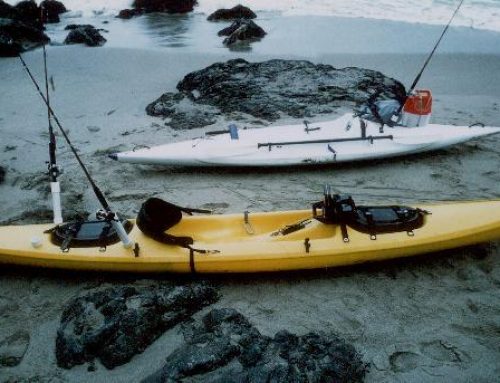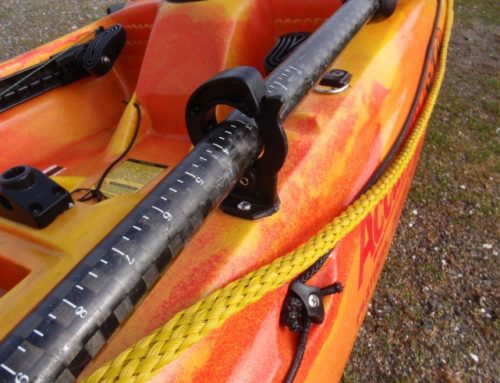Choosing a first Kayak explained…
“When I started promoting kayak fishing in the mid `90’s, I was preaching to anglers who either couldn’t afford power boating or didn’t want to spend the time or money to fish with a motor. In So Cal, anglers had little choice beyond fishing on party boats. With recreational kayaking exploding (due to the cheap plastic kayaks), anglers saw the simplicity and ease of access with these inexpensive craft. Kayak fishing was an easy fit that made a lot of sense. That was back in the day when Scuppers and Prisms were the common SOT fishing kayaks and cost about $600 bucks. There wasn’t much to choose from early on…longboards, canoes and fiberglass dive kayaks were all in the mix when plastic kayaks got their start.”
“Today, people from every walk of life, rich and poor from a growing number of countries and ethnicities, are getting into kayak fishing. With so many choices facing the first time buyer, having a big budget to run out and purchase one of the many “best fishing kayaks” isn’t always an advantage. The kayak needs to fit the angler, their primary fishery and be the best model for that angler’s overall needs, including cost. If 90% of your fishing is freshwater bass, you probably don’t need a heavy 15′ kayak that excels offshore. If you are a coastal angler, you don’t want a model that’s prone to wind issues or loses control in rough seas.”
A magazine cover once touted the nearly 200 “Best Fishing Kayaks”. In our experience, there are probably less than 2 dozen of “The Best Fishing Kayaks”. Less than a dozen of those are most of what you see on the water and that varies some from region to region. While some kayaks are better for offshore and others more suited for sweet water excursions, there is a kayak for every angler in every fishery at every price point. None-the-less, you may find a suitable model for less $ that hasn’t gained popularity (a sleeper) so drop us a line to help rule it in or out if you’re not sure.
When it comes to all the kayaks manufactured from here to the orient and back, there is a lot of junk out there. We don’t recommend some kayak brands due to a history of quality issues, antiquated manufacturing process, customer service issues and dealer and consumer feedback. We consider the quality of plastic, and additives like color, uv inhibitors and graphics We don’t recommend some brands simply because they haven’t caught on with anglers and we don’t have enough information to make a confident referral. It’s important that when we refer a fishing kayak model, you’ll still have it 10-35 years later.
The opinions and recommendations for specific fishing kayaks here are pretty much based on 4 things:
1. We don’t consider new models until companies get a chance to work out any bugs and consumers have the chance to prove them and provide us with feedback. That usually takes a year from when a new kayak model hits the water.
2. Design=Performance -Speed, tracking and seaworthiness in wind and chop.
3. Construction-Estimated kayak longevity fished by an angry gorilla, stored in the sun and repeatedly hammered in the surfzone. Manufacturing processes plus the instances of dealer and consumer complaints about fishing models are factored into our referrals.
4. Fishability- based on our experience and feedback from anglers everywhere
Used Fishing Kayaks – There is an ever swelling national market of used kayaks for most of the popular models used by dedicated anglers. Like surf, scuba and other recreational gear, kayaks get purchased new, used once or a few times and end up for sale on Craigslist within a few seasons. “When I was studying, selling cigars and fishing my kayak as a working student, a commercial diver in Oxnard California told me it was an industry understanding to find a new mask or fins in the classified ads. Well, fact is the same thing happens with fishing kayaks and gear. Many barely used deals sell cheap and often, a lot of accessory gear comes with it.
Adding to the complexity of purchasing a used kayak, there are instances of quality kayaks that we do recommend that have had issues in the past. Most were due to issues that are not uncommon to new kayaks. “I just saw one of those boats. We came off the water after a 5 hour session and a buddies kayak had several gallons of water in it. There was no obvious breach in the hull or deck. When I asked him what year it was, I knew he had a leaker. He bought it used so the only fix is to repair it. Most of these boats failed in the first years and the original owner probably never knew there was an issue.
New Fishing Kayaks – “I started basing my recommendations on fishable models that I felt would still be around if I ran into the person 10 or 12 years down the road. My first recommendations were the Scupper Classic and Pro. Kayakfishing as we know it was in the stone age then. While long out of production, I see 30 year old Scuppers all the time. Today’s boats might be made with newer materials but probably not as much plastic and with heavy use, are likely to wear out faster than those old Scuppers. If you can see your gear through the hull, I wouldn’t store it in the sun or stand on it. Anyway, most kayak companies started out as small manufacturers who put a lot of paddling soul (and plastic) into their products. Today, there are a lot more kayak manufacturers and most, not all, of the the dominate fishing brands are owned by a few very big companies. Many of today’s fishing kayaks are their own cousins. Like RTM and DAG. I think the industry of making kayaks has generally led to an increase in design and features and a decrease in the overall toughness of the product.
That said…If you store your new kayak on its side, in the shade and out of extreme heat, it could fish for 30 years+. Sun exposure, dragging, ongoing scratches and wear from transport will wear a boat out faster. Avoid hatch installations in the cockpit. “NEVER USE A WHEEL CART THAT MOUNTS IN THE SCUPPER HOLES!!! Even if the kayak manufacturer recommends it. Kayak anglers are more gorilla than kayaker. Using scupper mounted wheels on an 8 foot rec kayak across a parking lot is one thing, the weight of your fishing kayak could hurt the boat over any surface.” Baby your scupper holes.



